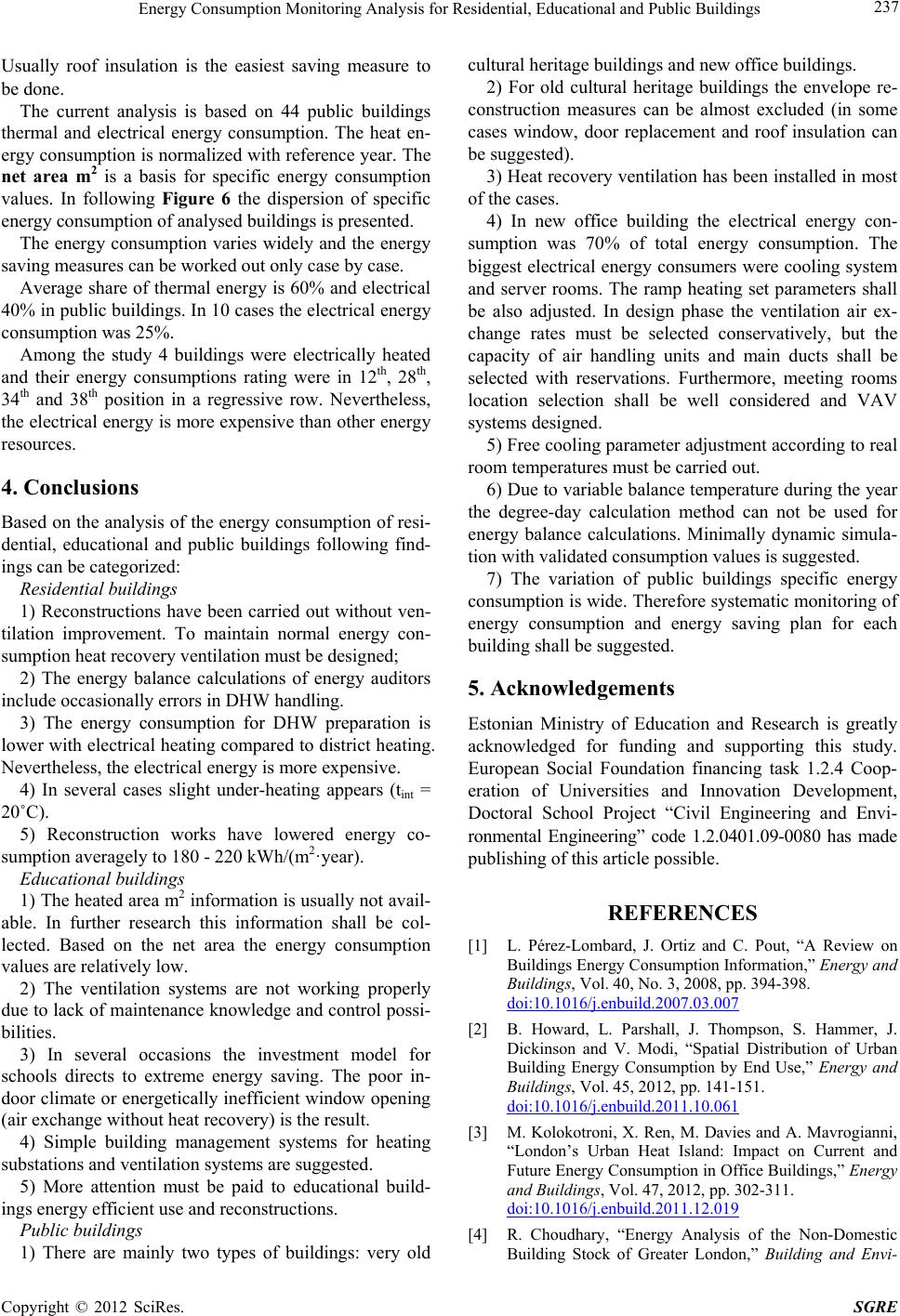
Energy Consumption Monitoring Analysis for Residential, Educational and Public Buildings 237
Usually roof insulation is the easiest saving measure to
be done.
The current analysis is based on 44 public buildings
thermal and electrical energy consumption. The heat en-
ergy consumption is normalized with reference year. The
net area m2 is a basis for specific energy consumption
values. In following Figure 6 the dispersion of specific
energy consumption of analysed buildings is presented.
The energy consumption varies widely and the energy
saving measures can be worked out only case by case.
Average share of thermal energy is 60% and electrical
40% in public buildings. In 10 cases the electrical energy
consumpt i on w a s 25%.
Among the study 4 buildings were electrically heated
and their energy consumptions rating were in 12th, 28th,
34th and 38th position in a regressive row. Nevertheless,
the electrical energy is more expensive than other energy
resources.
4. Conclusions
Based on the analysis of the energy consumption of resi-
dential, educational and public buildings following find-
ings can be categorized:
Residential buildings
1) Reconstructions have been carried out without ven-
tilation improvement. To maintain normal energy con-
sumption heat recovery ventilation must be designed;
2) The energy balance calculations of energy auditors
include occasionally errors in DHW handling.
3) The energy consumption for DHW preparation is
lower with electrical heating compared to district heating.
Nevertheless, the electrical energy is more expensive.
4) In several cases slight under-heating appears (tint =
20˚C).
5) Reconstruction works have lowered energy co-
sumption averagely to 180 - 220 kWh/ (m2·year).
Educational buildings
1) The heated area m2 information is usually not avail-
able. In further research this information shall be col-
lected. Based on the net area the energy consumption
values are relatively low.
2) The ventilation systems are not working properly
due to lack of maintenan ce knowledge and contro l possi-
bilities.
3) In several occasions the investment model for
schools directs to extreme energy saving. The poor in-
door climate or energetically inefficient wind ow opening
(air exchange without heat recovery) is the result.
4) Simple building management systems for heating
substations and ventilation systems are suggested.
5) More attention must be paid to educational build-
ings energy efficient use and reconstructions.
Public buildings
1) There are mainly two types of buildings: very old
cultural heritage buildings and new office buildings.
2) For old cultural heritage buildings the envelope re-
construction measures can be almost excluded (in some
cases window, door replacement and roof insulation can
be suggested).
3) Heat recovery ventilation ha s been installed in most
of the cases.
4) In new office building the electrical energy con-
sumption was 70% of total energy consumption. The
biggest electrical energy consumers were cooling system
and server rooms. The ramp heating set parameters shall
be also adjusted. In design phase the ventilation air ex-
change rates must be selected conservatively, but the
capacity of air handling units and main ducts shall be
selected with reservations. Furthermore, meeting rooms
location selection shall be well considered and VAV
systems designed.
5) Free cooling parameter adjustment according to real
room temperatures must be carried out.
6) Due to variable balance temperature during the year
the degree-day calculation method can not be used for
energy balance calculations. Minimally dynamic simula-
tion with validated consumption values is suggested.
7) The variation of public buildings specific energy
consumption is wide. Therefore systematic monitoring of
energy consumption and energy saving plan for each
building shall be suggested.
5. Acknowledgements
Estonian Ministry of Education and Research is greatly
acknowledged for funding and supporting this study.
European Social Foundation financing task 1.2.4 Coop-
eration of Universities and Innovation Development,
Doctoral School Project “Civil Engineering and Envi-
ronmental Engineering” code 1.2.0401.09-0080 has made
publishing of this article possible.
REFERENCES
[1] L. Pérez-Lombard, J. Ortiz and C. Pout, “A Review on
Buildings Energy Consumption Information,” Energy and
Buildings, Vol. 40, No. 3, 2008, pp. 394-398.
doi:10.1016/j.enbuild.2007.03.007
[2] B. Howard, L. Parshall, J. Thompson, S. Hammer, J.
Dickinson and V. Modi, “Spatial Distribution of Urban
Building Energy Consumption by End Use,” Energy and
Buildings, Vol. 45, 2012, pp. 141-151.
doi:10.1016/j.enbuild.2011.10.061
[3] M. Kolokotroni, X. Ren, M. Davies and A. Mavrogianni,
“London’s Urban Heat Island: Impact on Current and
Future Energy Consumption in Office Buildings,” Energy
and Buildings, Vol. 47, 2012, pp. 302-311.
doi:10.1016/j.enbuild.2011.12.019
[4] R. Choudhary, “Energy Analysis of the Non-Domestic
Building Stock of Greater London,” Building and Envi-
Copyright © 2012 SciRes. SGRE